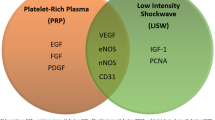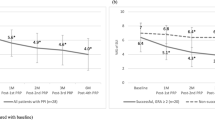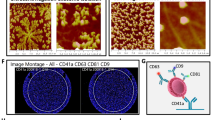Abstract
Stress urinary incontinence (SUI) is a common and bothersome condition. Anti-incontinence surgery has high cure rates, but concerns about mesh tapes have resulted in the resurgence of surgical procedures that involve increased abdominopelvic dissection and morbidity. Injection therapy with urethral bulking agents or stem cell formulations have been developed as minimally invasive alternatives. Many synthetic and biological bulking agents have been trialled, but several have been discontinued owing to safety concerns. The use of Macroplastique and Contigen has the largest evidence base, but, overall, success rates seem to be similar between the various agents and positive outcomes are poorly sustained for more than 6 months. Furthermore, subjective cure rates, although initially high, also deteriorate over time. The available data consistently demonstrate manifestly poorer outcomes for injection therapies than for surgery. Stem cell treatments are thought to functionally regenerate the urethral sphincter in patients with suspected intrinsic sphincter deficiency. Autologous adipose and muscle-derived stem cells seem to be the intuitive cell source, as they are comparatively abundant, can be harvested and cause minimal donor site morbidity. To date, only a few small clinical studies have been reported and most data are derived from animal models. The success rates of stem cell injection therapies seem to be comparable with those of bulking agents.
Key points
-
An increasing number of bulking procedures are being performed with objective cure rates that are inferior to those of open surgery, but their minimally invasive application is an attractive prospect.
-
The rates of subjective improvements for bulking agent therapies are high, but these treatments should not be offered to patients who seek a permanent cure of their stress urinary incontinence.
-
Stem cells derived from muscle or fat are the most commonly studied cells for use as a regenerative injection therapy.
-
Harvest and injection of stem cells seem not to have high rates of morbidity, and the outcomes of stem cell injections seem to be better maintained at 12 months than those of bulking agents.
-
Studies of labelled-cell injections to enable tracking demonstrate low stem cell proportions in the sphincter by 12 months; hence, paracrine effects of the cellular concentrate might be as important as the cells themselves.
-
The development of stem cell therapies is limited to preclinical and human feasibility studies, owing to the difficulty of assessing injected cell fate; thus, outcome measurements are limited to subjective and objective cure rates.
This is a preview of subscription content, access via your institution
Access options
Access Nature and 54 other Nature Portfolio journals
Get Nature+, our best-value online-access subscription
$29.99 / 30 days
cancel any time
Subscribe to this journal
Receive 12 print issues and online access
$209.00 per year
only $17.42 per issue
Buy this article
- Purchase on Springer Link
- Instant access to full article PDF
Prices may be subject to local taxes which are calculated during checkout


Similar content being viewed by others

Change history
26 May 2020
A Correction to this paper has been published: https://doi.org/10.1038/s41585-020-0340-x
References
Haylen, B. T. et al. An International Urogynecological Association (IUGA)/International Continence Society (ICS) joint report on the terminology for female pelvic floor dysfunction. Neurourol. Urodyn. 29, 4–20 (2010).
Abrams, P., Cardozo, L., Wagg, A. & Wein, A. Incontinence 6th edn (ICI-RS. International Continence Society, 2017).
Abrams, P. et al. 6th International Consultation on Incontinence. Recommendations of the International Scientific Committee: evaluation and treatment of urinary incontinence, pelvic organ prolapse and faecal incontinence. Neurourol. Urodyn. 37, 2271–2272 (2018).
Rortveit, G., Hannestad, Y. S., Daltveit, A. K. & Hunskaar, S. Age- and type-dependent effects of parity on urinary incontinence: the Norwegian EPINCONT study. Obstet. Gynecol. 98, 1004–1010 (2001).
Blaivas, J. G. & Olsson, C. A. Stress incontinence: classification and surgical approach. J. Urol. 139, 727–731 (1988).
McGuire, E. J., Lytton, B., Kohorn, E. I. & Pepe, V. The value of urodynamic testing in stress urinary incontinence. J. Urol. 124, 256–258 (1980).
McGuire, E. J., Lytton, B., Pepe, V. & Kohorn, E. I. Stress urinary incontinence. Obstet. Gynecol. 47, 255–264 (1976).
Kayigil, O., Iftekhar Ahmed, S. & Metin, A. The coexistence of intrinsic sphincter deficiency with type II stress incontinence. J. Urol. 162, 1365–1366 (1999).
McGuire, E. J. Urodynamic findings in patients after failure of stress incontinence operations. Prog. Clin. Biol. Res. 78, 351–360 (1981).
Shah, H. N. & Badlani, G. H. Mesh complications in female pelvic floor reconstructive surgery and their management: a systematic review. Indian. J. Urol. 28, 129–153 (2012).
Blaivas, J. G. et al. Safety considerations for synthetic sling surgery. Nat. Rev. Urol. 12, 481–509 (2015).
Kuismanen, K. et al. Autologous adipose stem cells in treatment of female stress urinary incontinence: results of a pilot study. Stem Cell Transl Med. 3, 936–941 (2014).
Davis, N. F., Kheradmand, F. & Creagh, T. Injectable biomaterials for the treatment of stress urinary incontinence: their potential and pitfalls as urethral bulking agents. Int. Urogynecol. J. 24, 913–919 (2013).
Rud, T., Andersson, K. E., Asmussen, M., Hunting, A. & Ulmsten, U. Factors maintaining the intraurethral pressure in women. Invest. Urol. 17, 343–347 (1980).
Onuf, B. Notes on the arrangement and function of the cell groups in the sacral region of the spinal cord. J. Nerv. Ment. Dis. 26, 498–504 (1899).
Sand, P. K., Bowen, L. W., Panganiban, R. & Ostergard, D. R. The low pressure urethra as a factor in failed retropubic urethropexy. Obstet. Gynecol. 69, 399–402 (1987).
Betson, L. H., Siddiqui, G. & Bhatia, N. N. Intrinsic urethral sphincteric deficiency: critical analysis of various diagnostic modalities. Curr. Opin. Obstet. Gynecol. 15, 411–417 (2003).
McGuire, E. J. et al. Clinical assessment of urethral sphincter function. J. Urol. 150, 1452–1454 (1993).
Parker, R. The paraffin injection treatment of Gersuny, with a report of cases. JAMA XXXVIII, 1000–1003 (1902).
Murless, B. The injection treatment of stress incontinence. J. Obstet. Gynaecol. Br. Emp. 45, 521–524 (1938).
Sachse, H. Treatment of urinary incontinence with sclerosing solutions. Indications, results, complications. Urol. Int. 15, 225–244 (1963).
Dmochowski, R. R. & Appell, R. A. Injectable agents in the treatment of stress urinary incontinence in women: where are we now? Urology 56, 32–40 (2000).
Chaliha, C. & Williams, G. Periurethral injection therapy for the treatment of urinary incontinence. Br. J. Urol. 76, 151–155 (1995).
Lee, P. E., Kung, R. C. & Drutz, H. P. Periurethral autologous fat injection as treatment for female stress urinary incontinence: a randomized double-blind controlled trial. J. Urol. 165, 153–158 (2001).
Mayer, R. D. et al. Multicenter prospective randomized 52-week trial of calcium hydroxylapatite versus bovine dermal collagen for treatment of stress urinary incontinence. Urology 69, 876–880 (2007).
Lightner, D. et al. A new injectable bulking agent for treatment of stress urinary incontinence: results of a multicenter, randomized, controlled, double-blind study of Durasphere. Urology 58, 12–15 (2001).
Sokol, E. R., Karram, M. M. & Dmochowski, R. Efficacy and safety of polyacrylamide hydrogel for the treatment of female stress incontinence: a randomized, prospective, multicenter North American study. J. Urol. 192, 843–849 (2014).
Lose, G., Mouritsen, L. & Nielsen, J. B. A new bulking agent (polyacrylamide hydrogel) for treating stress urinary incontinence in women. BJU Int. 98, 100–104 (2006).
Reynolds, W. S. & Dmochowski, R. R. Urethral bulking: a urology perspective. Urol. Clin. North. Am. 39, 279–287 (2012).
Henly, D. R. et al. Particulate silicone for use in periurethral injections: local tissue effects and search for migration. J. Urol. 153, 2039–2043 (1995).
Hurtado, E. A. & Appell, R. A. Complications of tegress injections. Int. Urogynecol J. Pelvic Floor. Dysfunct. 20, 127; author reply 129 (2009).
Lightner, D. et al. Randomized controlled multisite trial of injected bulking agents for women with intrinsic sphincter deficiency: mid-urethral injection of Zuidex via the implacer versus proximal urethral injection of Contigen cystoscopically. Urology 74, 771–775 (2009).
Kulkarni, S., Davies, A. J., Treurnicht, K., Dudderidge, T. J. & Al-Akraa, M. Misplaced macroplastique injection presenting as a vaginal nodule and a bladder mass. Int. J. Clin. Pract. Suppl. https://doi.org/10.1111/j.1368-504x.2005.00287.x (2005).
Kirchin, V. et al. Urethral injection therapy for urinary incontinence in women. Cochrane Database Syst. Rev. 7, CD003881 (2017).
Klarskov, N. & Lose, G. Urethral injection therapy: what is the mechanism of action? Neurourol. Urodyn. 27, 789–792 (2008).
Pickard, R. et al. Periurethral injection therapy for urinary incontinence in women. Cochrane Database Syst. Rev. 3, CD003881 (2003).
Schulz, J. A., Nager, C. W., Stanton, S. L. & Baessler, K. Bulking agents for stress urinary incontinence: short-term results and complications in a randomized comparison of periurethral and transurethral injections. Int. Urogynecol. J. Pelvic Floor Dysfunct. 15, 261–265 (2004).
Mitterberger, M. et al. Comparison of the precision of transurethral endoscopic versus ultrasound-guided application of injectables. BJU Int. 101, 245–249 (2008).
Kuhn, A., Stadlmayr, W., Lengsfeld, D. & Mueller, M. D. Where should bulking agents for female urodynamic stress incontinence be injected? Int. Urogynecol. J. Pelvic Floor Dysfunct. 19, 817–821 (2008).
Ghoniem, G. et al. Cross-linked polydimethylsiloxane injection for female stress urinary incontinence: results of a multicenter, randomized, controlled, single-blind study. J. Urol. 181, 204–210 (2009).
Bano, F., Barrington, J. W. & Dyer, R. Comparison between porcine dermal implant (Permacol) and silicone injection (Macroplastique) for urodynamic stress incontinence. Int. Urogynecol. J. Pelvic Floor Dysfunct. 16, 147–150; discussion 150 (2005).
ter Meulen, P. H., Berghmans, L. C., Nieman, F. H. & van Kerrebroeck, P. E. Effects of macroplastique implantation system for stress urinary incontinence and urethral hypermobility in women. Int. Urogynecol. J. Pelvic Floor Dysfunct. 20, 177–183 (2009).
Corcos, J. et al. Multicenter randomized clinical trial comparing surgery and collagen injections for treatment of female stress urinary incontinence. Urology 65, 898–904 (2005).
Maher, C. F. et al. Pubovaginal sling versus transurethral macroplastique for stress urinary incontinence and intrinsic sphincter deficiency: a prospective randomised controlled trial. BJOG 112, 797–801 (2005).
Gaddi, A., Guaderrama, N., Bassiouni, N., Bebchuk, J. & Whitcomb, E. L. Repeat midurethral sling compared with urethral bulking for recurrent stress urinary incontinence. Obstet. Gynecol. 123, 1207–1212 (2014).
Scottish Government. The Scottish independent review of the use, safety and efficacy of transvaginal mesh implants in the treatment of stress urinary incontinence and pelvic organ prolapse in women: final report. Scottish Government https://www.gov.scot/publications/scottish-independent-review-use-safety-efficacy-transvaginal-mesh-implants-treatment-9781786528711/pages/6/ (2017).
Siddiqui, Z. A., Abboudi, H., Crawford, R. & Shah, S. Intraurethral bulking agents for the management of female stress urinary incontinence: a systematic review. Int. Urogynecol. J. 28, 1275–1284 (2017).
Andersen, R. C. Long-term follow-up comparison of durasphere and contigen in the treatment of stress urinary incontinence. J. Low. Genit. Tract. Dis. 6, 239–243 (2002).
Lose, G. et al. An open multicenter study of polyacrylamide hydrogel (Bulkamid(R)) for female stress and mixed urinary incontinence. Int. Urogynecol. J. 21, 1471–1477 (2010).
Burkhard, F. C., Bosch, J. L. H. R., Cruz, F., Lemack, G. E. & Nambiar, A. K. EAU guidelines on urinary incontinence in adults. EAU https://uroweb.org/wp-content/uploads/EAU-Guidelines-on-Urinary-Incontinence_2018-V3.pdf (2018).
Kobashi, K. C. et al. Surgical treatment of female stress urinary incontinence: AUA/SUFU guideline. J. Urol. 198, 875–883 (2017).
Martinez-Climent, J. A., Andreu, E. J. & Prosper, F. Somatic stem cells and the origin of cancer. Clin. Transl. Oncol. 8, 647–663 (2006).
Lee, J. Y. et al. Clonal isolation of muscle-derived cells capable of enhancing muscle regeneration and bone healing. J. Cell Biol. 150, 1085–1100 (2000).
Qu-Petersen, Z. et al. Identification of a novel population of muscle stem cells in mice: potential for muscle regeneration. J. Cell Biol. 157, 851–864 (2002).
Cannon, T. W. et al. Improved sphincter contractility after allogenic muscle-derived progenitor cell injection into the denervated rat urethra. Urology 62, 958–963 (2003).
Chancellor, M. B. et al. Preliminary results of myoblast injection into the urethra and bladder wall: a possible method for the treatment of stress urinary incontinence and impaired detrusor contractility. Neurourol. Urodyn. 19, 279–287 (2000).
Chermansky, C. J. et al. Intraurethral muscle-derived cell injections increase leak point pressure in a rat model of intrinsic sphincter deficiency. Urology 63, 780–785 (2004).
Lee, J. Y. et al. The effects of periurethral muscle-derived stem cell injection on leak point pressure in a rat model of stress urinary incontinence. Int. Urogynecol. J. Pelvic Floor Dysfunct. 14, 31–37; discussion 37 (2003).
Lee, J. Y. et al. Long term effects of muscle-derived stem cells on leak point pressure and closing pressure in rats with transected pudendal nerves. Mol. Cell 18, 309–313 (2004).
Tamaki, T. et al. Functional recovery of damaged skeletal muscle through synchronized vasculogenesis, myogenesis, and neurogenesis by muscle-derived stem cells. Circulation 112, 2857–2866 (2005).
Badra, S., Andersson, K. E., Dean, A., Mourad, S. & Williams, J. K. Long-term structural and functional effects of autologous muscle precursor cell therapy in a nonhuman primate model of urinary sphincter deficiency. J. Urol. 190, 1938–1945 (2013).
Williams, J. K. et al. The dose-effect safety profile of skeletal muscle precursor cell therapy in a dog model of intrinsic urinary sphincter deficiency. Stem Cell Transl Med. 4, 286–294 (2015).
Mitterberger, M. et al. Autologous myoblasts and fibroblasts for female stress incontinence: a 1-year follow-up in 123 patients. BJU Int. 100, 1081–1085 (2007).
Carr, L. K. et al. Autologous muscle derived cell therapy for stress urinary incontinence: a prospective, dose ranging study. J. Urol. 189, 595–601 (2013).
Gras, S., Klarskov, N. & Lose, G. Intraurethral injection of autologous minced skeletal muscle: a simple surgical treatment for stress urinary incontinence. J. Urol. 192, 850–855 (2014).
Blaganje, M. & Lukanovic, A. Intrasphincteric autologous myoblast injections with electrical stimulation for stress urinary incontinence. Int. J. Gynaecol. Obstet. 117, 164–167 (2012).
Peters, K. M. et al. Autologous muscle derived cells for treatment of stress urinary incontinence in women. J. Urol. 192, 469–476 (2014).
Ning, H., Lin, G., Lue, T. F. & Lin, C. S. Neuron-like differentiation of adipose tissue-derived stromal cells and vascular smooth muscle cells. Differentiation 74, 510–518 (2006).
Zuk, P. A. et al. Multilineage cells from human adipose tissue: implications for cell-based therapies. Tissue Eng. 7, 211–228 (2001).
Miranville, A. et al. Improvement of postnatal neovascularization by human adipose tissue-derived stem cells. Circulation 110, 349–355 (2004).
Miyahara, Y. et al. Monolayered mesenchymal stem cells repair scarred myocardium after myocardial infarction. Nat. Med. 12, 459–465 (2006).
Gotoh, M. et al. Regenerative treatment of male stress urinary incontinence by periurethral injection of autologous adipose-derived regenerative cells: 1-year outcomes in 11 patients. Int. J. Urol. 21, 294–300 (2014).
Kong, K. Y., Ren, J., Kraus, M., Finklestein, S. P. & Brown, R. H. Jr. Human umbilical cord blood cells differentiate into muscle in sjl muscular dystrophy mice. Stem Cell 22, 981–993 (2004).
Lee, C. N. et al. Human cord blood stem cell therapy for treatment of stress urinary incontinence. J. Korean Med. Sci. 25, 813–816 (2010).
Pittenger, M. F. et al. Multilineage potential of adult human mesenchymal stem cells. Science 284, 143–147 (1999).
Kinebuchi, Y. et al. Autologous bone-marrow-derived mesenchymal stem cell transplantation into injured rat urethral sphincter. Int. J. Urol. 17, 359–368 (2010).
Gunetti, M. et al. Myogenic potential of whole bone marrow mesenchymal stem cells in vitro and in vivo for usage in urinary incontinence. PLoS One 7, e45538 (2012).
Roman, S. et al. Developing a tissue engineered repair material for treatment of stress urinary incontinence and pelvic organ prolapse-which cell source? Neurourol. Urodyn. 33, 531–537 (2014).
Amend, B. et al. Precise injection of human mesenchymal stromal cells in the urethral sphincter complex of Gottingen minipigs without unspecific bulking effects. Neurourol. Urodyn. 36, 1723–1733 (2017).
Deng, K. et al. Mesenchymal stem cells and their secretome partially restore nerve and urethral function in a dual muscle and nerve injury stress urinary incontinence model. Am. J. Physiol. Ren. Physiol. 308, F92–F100 (2015).
Dissaranan, C. et al. Rat mesenchymal stem cell secretome promotes elastogenesis and facilitates recovery from simulated childbirth injury. Cell Transpl. 23, 1395–1406 (2014).
Williams, J. K. et al. Cell versus chemokine therapy in a nonhuman primate model of chronic intrinsic urinary sphincter deficiency. J. Urol. 196, 1809–1815 (2016).
Sebe, P. et al. Intrasphincteric injections of autologous muscular cells in women with refractory stress urinary incontinence: a prospective study. Int. Urogynecol. J. 22, 183–189 (2011).
Acknowledgements
C.J.H., S.M., W.K.A., A.S. and C.R.C are members of the Regenerative Sphincter Therapy (ReST) Consortium funded by the European Cooperation in Science and Technology (COST).
Review criteria
A search of the PubMed and Scopus databases was performed to identify articles published between 1995 and May 2018 using the following search terms: “bulking agent”, “urethral injection”, “regenerative medicine” and “stem cell injection”. Results were limited to “stress urinary incontinence”. All available randomized controlled trials, cohort studies and case series were included in this narrative review.
Author information
Authors and Affiliations
Contributions
C.J.H. and S.R. researched data for the article. All authors made substantial contributions to the discussion of content and wrote the manuscript. C.J.H., S.M., W.K.A., A.S. and C.R.C. reviewed and/or edited the manuscript before submission.
Corresponding author
Ethics declarations
Competing interests
The authors declare no competing interests.
Additional information
Publisher’s note
Springer Nature remains neutral with regard to jurisdictional claims in published maps and institutional affiliations.
Rights and permissions
About this article
Cite this article
Hillary, C.J., Roman, S., MacNeil, S. et al. Regenerative medicine and injection therapies in stress urinary incontinence. Nat Rev Urol 17, 151–161 (2020). https://doi.org/10.1038/s41585-019-0273-4
Accepted:
Published:
Issue Date:
DOI: https://doi.org/10.1038/s41585-019-0273-4
This article is cited by
-
Stem cell therapy combined with controlled release of growth factors for the treatment of sphincter dysfunction
Cell & Bioscience (2023)
-
Body fluid-derived stem cells — an untapped stem cell source in genitourinary regeneration
Nature Reviews Urology (2023)


